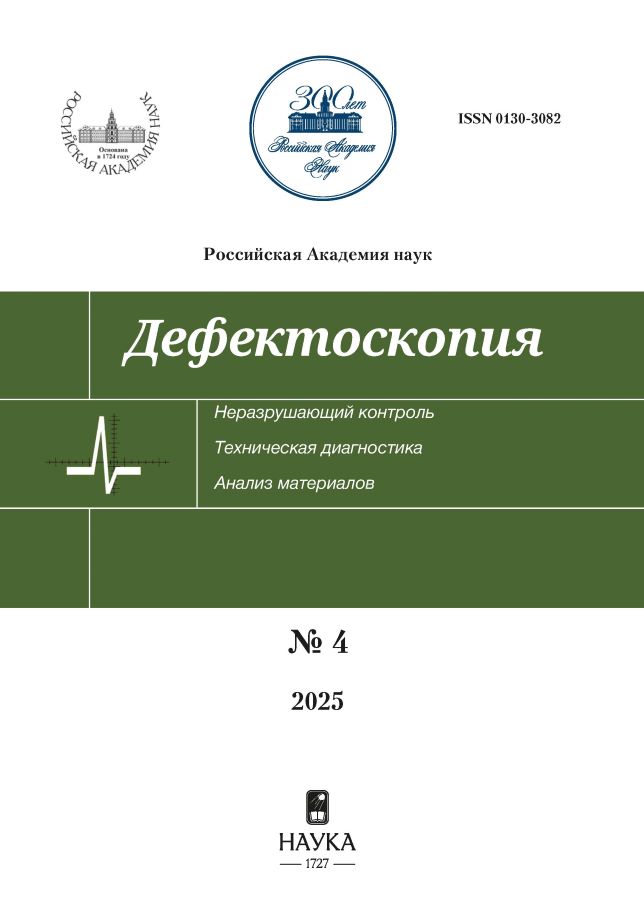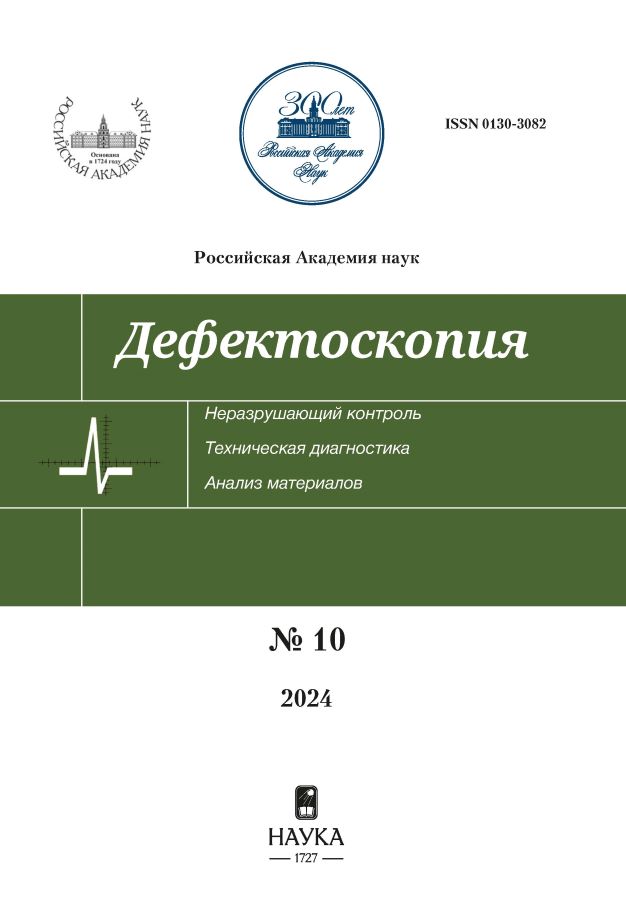Measuring the Viscosity of Sulphur Melt by the Proton Microscopy Method
- Authors: Khurchiev A.O.1, Gavrilin R.O.1, Skoblyakov A.V.1, Kantsyrev A.V.1, Golubev A.A.1, Mintsev V.B.2, Nikolaev D.N.2, Shilkin N.S.2, Belikov R.S.3
-
Affiliations:
- Kurchatov Institute
- Federal Research Center of Problems of Chemical Physics and Medicinal Chemistry of the RAS
- Goethe University Frankfurt
- Issue: No 10 (2024)
- Pages: 28-35
- Section: Radiation methods
- URL: https://permmedjournal.ru/0130-3082/article/view/649300
- DOI: https://doi.org/10.31857/S0130308224100035
- ID: 649300
Cite item
Abstract
Sulfur is a substance with an abnormal dependence of viscosity on temperature. An experimental setup was created to study the viscosity of sulfur at pressures up to 100 bar and temperatures up to 500 °C. To visualize the process of falling of a tungsten carbide ball located in molten sulfur, the proton radiography method was used. The experiment was carried out on a PRIOR-II proton microscope (Institute for Heavy Ion Research, GSI, Darmstadt, Germany). In this experiment, the operating mode of the SIS-18 accelerator with slow beam extraction was used for the first time for proton radiography. The viscosity of the sulfur melt was measured at a pressure of 90 bar and temperatures of 190—320 °C. It has been shown that the viscosity of sulfur is greatly influenced by impurities, including hydrogen sulfide, which appears in the molten sulfur at high temperatures.
Keywords
Full Text
About the authors
A. O. Khurchiev
Kurchatov Institute
Author for correspondence.
Email: ayuxa@inbox.ru
Russian Federation, Moscow
R. O. Gavrilin
Kurchatov Institute
Email: ayuxa@inbox.ru
Russian Federation, Moscow
A. V. Skoblyakov
Kurchatov Institute
Email: ayuxa@inbox.ru
Russian Federation, Moscow
A. V. Kantsyrev
Kurchatov Institute
Email: ayuxa@inbox.ru
Russian Federation, Moscow
A. A. Golubev
Kurchatov Institute
Email: ayuxa@inbox.ru
Russian Federation, Moscow
V. B. Mintsev
Federal Research Center of Problems of Chemical Physics and Medicinal Chemistry of the RAS
Email: ayuxa@inbox.ru
Russian Federation, Chernogolovka
D. N. Nikolaev
Federal Research Center of Problems of Chemical Physics and Medicinal Chemistry of the RAS
Email: ayuxa@inbox.ru
Russian Federation, Chernogolovka
N. S. Shilkin
Federal Research Center of Problems of Chemical Physics and Medicinal Chemistry of the RAS
Email: ayuxa@inbox.ru
Russian Federation, Chernogolovka
R. S. Belikov
Goethe University Frankfurt
Email: ayuxa@inbox.ru
Germany, Frankfurt am Main
References
- Sofekun G.O. Rheometric Properties of Pure Liquid Elemental Sulfur. Master’s thesis. Calgary, Canada: University of Calgary, 2017.
- Steudel R. Liquid sulfur // Top. Curr. Chem. 2003. No. 230. P. 81—116.
- Doi T. Physico-chemical properties of sulfur, 1. Pressure effects on viscosity of liquid // Rev. Phys. Chem. Jap. 1963. No. 33. P. 41—52.
- Tobolsky A.V., Eisenberg A. Equilibrium Polymerization of Sulfur // J. Am. Chem. Soc. 1959. V. 81. P. 780—782.
- Touro F.J., Wiewiorowski T.K. Viscosity-chain length relationship in molten sulfur system // J. Phys. Chem. 1966. V. 70. P. 239—241.
- Eisenberg A. The viscosity of liquid sulfur: A mechanistic reinterpretation // Macromolecules. 1968. No. 2. P. 44—48.
- Cates M.E. Theory of the viscosity of polymeric liquid sulfur // Europhys. Lett. 1987. No. 4. P. 497—502.
- Bacon R., Fanelli R. The viscosity of sulfur // J. Am. Chem. Soc. 1943. V. 65. P. 639—648.
- Terasaki H., Kato T., Funakoshi K., Suzuki A., Urakawa S. Viscosity of sulfur under high pressure // J. Phys., Condens. Matt. 2004. V. 16. P. 1707—1714.
- Powell E., Eyring H. The properties of liquid sulfur // J. Am. Chem. Soc. 1943. No. 4. V. 65. P. 648–654.
- Sukara Reynold E., Secco Richard A. Viscosity of liquid sulfur at 4.5 GPa in the L and L’ regions // High Pressure Research: An International Journal. 2012. No. 32:4. P. 451—456.
- Kantsyrev A.V., Golubev A.A., Bogdanov A.V., Demidov V.S., Demidova E.V., Ladygina E.M., Markov N.V., Skachkov V.S., Smirnov G.N., Rudskoy I.V., Kuznetsov A.P., Khudomyasov A.V., Sharkov B.Yu., Dudin S.V., Kolesnikov S.A., Mintsev V.B., Nikolaev D.N., Ternovoi V.Ya., Utkin A.V., Yuriev D.S., Shilkin N.S., Fortov V.E., Turtikov V.I., Burtsev V.V., Zhernokletov M.V., Zavialov N.V., Kartanov S.A., Mikhailov A.L., Rudnev A.V., Tatsenko M.V., Varentsov D.V., Shestov L.M. TWAC-ITEP Proton Microscopy Facility // Instruments and Experimental Techniques. 2014. V. 57. No. 1. P. 1—10.
- Varentsov D., Antonov O., Bakhmutova A., Barnes C.W., Bogdanov A., Danly C.R., Efimov S., Endres M., Fertman A., Golubev A.A., Hoffmann D.H.H., Ionita B., Kantsyrev A., Krasik Ya.E., Lang P.M., Lomonosov I., Mariam F.G., Markov N., Merrill F.E., Mintsev V.B., Nikolaev D., Panyushkin V., Rodionova M., Schanz M., Schoenberg K., Semennikov A., Shestov L., Skachkov V.S., Turtikov V., Udrea S., Vasylyev O., Weyrich K., Wilde C., Zubareva A. Commissioning of the PRIOR proton microscope // Review of Scientific Instruments. 2016. V. 87. Is. 2. P. 023303/1—023303/8.
- Sofekun G.O., Evoy E., Lesage K.L., Chou N., Marriot R.A. The rheology of liquid elemental sulfur across the λ-transition // Journal of Rheology. 2018. V. 62. P. 469—476.
- Stashick M.J., Sofekun G.O., Marriott R.A. Modifying effects of hydrogen sulfide on the rheometric properties of liquid elemental sulfur // AIChE J. 2020. V. 66. Is. 6.
- Timrot D.L., Serednitskaya M.A., Medveditskov A.N. Experimental study of the viscosity of the binary system sulfur — iodine in the temperature range of 360—900 K // High Temperature Thermal Physics. 1985. V. 23. No. 5. P. 882—889.
Supplementary files


















